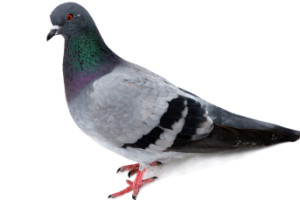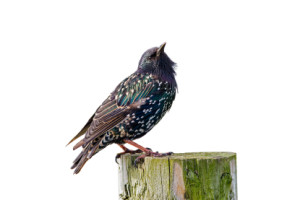
Pigeon (Columba Livia)
Appearance
Large, squat bird with a slender bill and short neck
Color
Gray and white bodies with black bands on wings and tail
Size
Adults grow up to 11 inches tall
Habitat
Having become quite dependent on humans, pigeons are found around urban areas – parks, bridges, restaurants – as well as agricultural settings, such as barns, feed mills and warehouses
Interesting Facts
Pigeons are monogamous, laying only one or two eggs
About the Pigeon
As one of the first animals domesticated by humans (likely the first), pigeons have a long-standing relationship with people. Today, the pigeons we’re familiar with have become reliant on humans for sustenance; however, there are over 300 varieties of pigeons throughout the world.
Dedicated to one partner their entire lives, pigeons dwell in flimsily constructed nests or within man-made structures, such as overpasses and building stoops. They tend to gather in bulk, presenting significant inconveniences for humans.
Pigeon Control
Pigeons have grown into a nuisance bird, especially in urban and agricultural areas. Their droppings are copious and can be dangerous in highly trafficked locations. They can also carry fungi and bacteria harmful to human health. Additionally, other parasites travel on pigeons, such as fleas, ticks, mites and lice.
Pigeon prevention and control is something Strategic Industries is very familiar with in and around Atlanta. For the property owner’s part, it’s imperative to make roosting areas undesirable; fill in gaps and voids around the property that make ideal nesting spaces; and ensure that food sources and standing water are unavailable.

English House Sparrow
Appearance
Small, chunky birds with broad chests, short tails and rounded heads
Color
Males are gray and white with black bibs, and females are more consistently colored dingy gray and brown with striped backs
Size
Adults are about 16 centimeters long
Habitat
Human dwellings and among trees near populated areas; agricultural settings, such as farmland
Interesting Facts
House sparrows clean themselves in dust baths, tossing dirt all over their feathers – the small hole this action creates is often defended against other sparrows
About the House Sparrow
Sparrows are very adaptable birds, and although they are predominately, and by nature, consumers of grain, they have developed the ability to feed off of the refuse of humans – from garbage cans, yard trimmings and urban debris.
They nest by filling small holes and gaps with dried roughage, such as pine straw, grass and small twigs. Nests are lines with softer material, such as string, fabric pieces and feathers.
When on the ground, sparrows hop, as opposed to walking, and they have a nervous appearance, twitching and flicking their tails frequently.
House Sparrow Control
Because of their eating and roosting habits, your best prevention method is to keep trash cans secured; openings and voids around the property (such as those under eaves and porches) blocked off; and to be mindful of nests in nearby trees and bushes.

European Starling
Appearance
Stocky, triangle-shaped wings, long bills and short tails
Color
Blackish appearance with yellow beaks; in winter, they turn brownish and acquire white spots
Size
Adults are about 20 centimeters long
Habitat
Human environments, such as cities and suburbs; also prolific in rural areas where humans live because they depend on lawns, parks and fields for foraging
Interesting Facts
European Starlings are skilled songbird mimics and have been known to replicate the songs of over 20 different species of birds
About the European Starling
European Starlings have adapted to a diverse diet, but they prefer to dine on insects and invertebrates, such as worms. For this reason, you’ll find them taking advantage of fields, freshly mowed lawns and parks.
European Starlings are seen as aggressive birds, fiercely defending their mates, their foraging grounds and their carefully constructed nests. Like sparrows, they fill small spaces with roughage that is then lined with softer materials, and during the incubation period, European Starlings use fresh, green material to control the temperature within a nest.
European Starling Control
European Starlings are fast moving birds, and they cleverly place their nests in areas difficult to remove, such as high wires.
Because they are so territorial, we recommend leaving them alone and contacting a professional for removal and further prevention.


